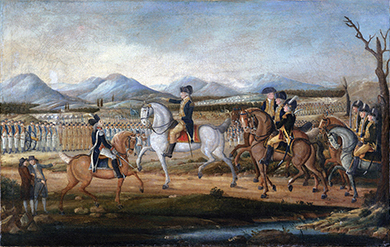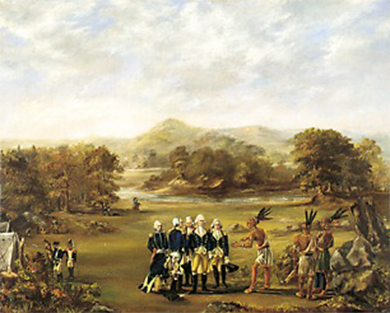| << Chapter < Page | Chapter >> Page > |
With their emphasis on personal freedoms, the whiskey rebels aligned themselves with the Democratic-Republican Party. They saw the tax as part of a larger Federalist plot to destroy their republican liberty and, in its most extreme interpretation, turn the United States into a monarchy. The federal government lowered the tax, but when federal officials tried to subpoena those distillers who remained intractable, trouble escalated. Washington responded by creating a thirteen-thousand-man militia, drawn from several states, to put down the rebellion ( [link] ). This force made it known, both domestically and to the European powers that looked on in anticipation of the new republic’s collapse, that the national government would do everything in its power to ensure the survival of the United States.

Alexander Hamilton frequently wrote persuasive essays under pseudonyms, like “Tully,” as he does here. In this 1794 essay, Hamilton denounces the whiskey rebels and majority rule.
It has been observed that the means most likely to be employed to turn the insurrection in the western country to the detriment of the government, would be artfully calculated among other things ‘to divert your attention from the true question to be decided.’
Let us see then what is this question. It is plainly this—shall the majority govern or be governed? shall the nation rule, or be ruled? shall the general will prevail, or the will of a faction? shall there be government, or no government? . . .
The Constitution you have ordained for yourselves and your posterity contains this express clause, ‘The Congress shall have power to lay and collect taxes, duties, imposts, and Excises , to pay the debts, and provide for the common defence and general welfare of the United States.’ You have then, by a solemn and deliberate act, the most important and sacred that a nation can perform, pronounced and decreed, that your Representatives in Congress shall have power to lay Excises. You have done nothing since to reverse or impair that decree. . . .
But the four western counties of Pennsylvania, undertake to rejudge and reverse your decrees, you have said, ‘The Congress shall have power to lay Excises .’ They say, ‘The Congress shall not have this power.’ . . .
There is no road to despotism more sure or more to be dreaded than that which begins at anarchy .”
—Alexander Hamilton’s “Tully No. II” for the American Daily Advertiser , Philadelphia, August 26, 1794
What are the major arguments put forward by Hamilton in this document? Who do you think his audience is?
Relationships with Indians were a significant problem for Washington’s administration, but one on which white citizens agreed: Indians stood in the way of white settlement and, as the 1790 Naturalization Act made clear, were not citizens. After the War of Independence, white settlers poured into lands west of the Appalachian Mountains. As a result, from 1785 to 1795, a state of war existed on the frontier between these settlers and the Indians who lived in the Ohio territory. In both 1790 and 1791, the Shawnee and Miami had defended their lands against the whites who arrived in greater and greater numbers from the East. In response, Washington appointed General Anthony Wayne to bring the Western Confederacy—a loose alliance of tribes—to heel. In 1794, at the Battle of Fallen Timbers, Wayne was victorious. With the 1795 Treaty of Greenville ( [link] ), the Western Confederacy gave up their claims to Ohio.

Federalists and Democratic-Republicans interpreted the execution of the French monarch and the violent establishment of a French republic in very different ways. Revolutionaries’ excesses in France and the slaves’ revolt in the French colony of Haiti raised fears among Federalists of similar radicalism and slave uprisings on American shores. They looked to better relationships with Great Britain through Jay’s Treaty. Pinckney’s Treaty, which came about as a result of Jay’s Treaty, improved U.S. relations with the Spanish and opened the Spanish port of New Orleans to American commerce. Democratic-Republicans took a more positive view of the French Revolution and grew suspicious of the Federalists when they brokered Jay’s Treaty. Domestically, the partisan divide came to a dramatic head in western Pennsylvania when distillers of whiskey, many aligned with the Democratic-Republicans, took action against the federal tax on their product. Washington led a massive force to put down the uprising, demonstrating Federalist intolerance of mob action. Though divided on many issues, the majority of white citizens agreed on the necessity of eradicating the Indian presence on the frontier.

Notification Switch
Would you like to follow the 'U.s. history' conversation and receive update notifications?